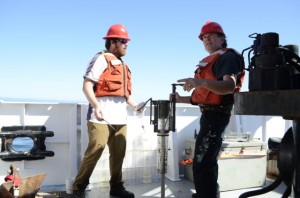This is my first trip out on the Pacific, all my time has been spent in the Gulf of Mexico, and the sights leaving the dock could not be more different. Instead of alligators, shrimp trawls, and oil rigs I see otters, seals, and even whales in the background (my first whale encounter). My previous cruises have all been very focused with everyone working on one problem, getting mud from the bottom of the Gulf onto the boat and into jars. Seeing trawls and gravity cores is quite exciting. The first stations were mine, and problems of course arose on the first station. However, we managed to overcome them and get relatively good samples. My goal on the trip is to sample a few seeps, or areas where hydrocarbons such as methane reach the seafloor from deep underground. These areas are hotspots of biological activity as hydrocarbons are a source of energy for animals in an otherwise food limiting deep ocean. The hardest part of sampling a seep from the surface without a submersible is actually dropping your equipment in the right spot, as these seeps are often small. Ship positioning is never exact and when something is dropped over the side of the boat down several hundred meters it is rare that it drops straight down due to currents. So with much anticipation I waited on deck for the corer to come to the surface with my precious samples and hoped that there would be some sort of evidence that we had hit the mark. When the corer comes up I can see there is indeed mud contained within, and upon further inspection a notice small red shrimp, caprellid amphipods, and worm tubes on the surface of each core. Jackpot! While we may not have hit directly on top of the seep we are very likely in the vicinity as these shrimp are often associated with seeps, and the likelihood of capturing multiple shrimp in several different cores on bare deep seafloor are remote at best. Once the cores are back on deck I cut them into 3 different sections down to 10 cm in depth, as this is where all the animals are generally found. While processing the cores we notice some sort of precipitate in the mud, another hint that we may be close to a seep. I could not be more pleased. Due to the cost of sampling, no one has yet had a chance to look at the differences in animals within a seep. Generally studies can only afford to take one or two samples at a given location before moving to the next spot. This research may be able to better help people sample this environment in the future. We move on to stations 2 and 3, but difficulties with the corer prevent us from getting samples here. With any luck we will have time to go back to the original station, where the shrimp were found, to get more samples and further flesh out just how many differences are found within this very dynamic habitat. Until then I will enjoy helping the rest of the scientists with their research and learning how to use some very cool and different equipment as well as how to be a chief scientist.
Travis and Kenneth extruding the core sample.
(Photo credit: Amanda Netburn)
